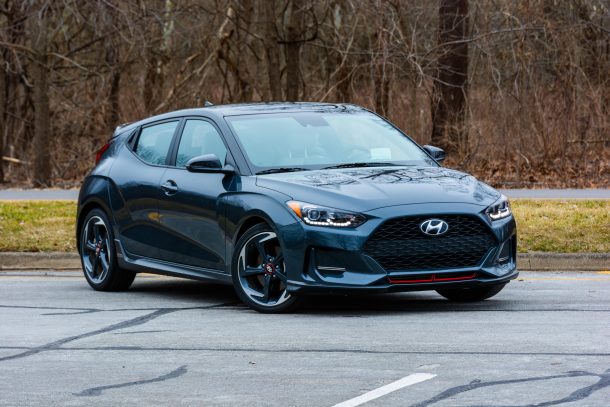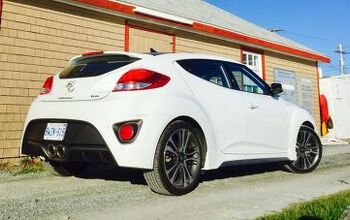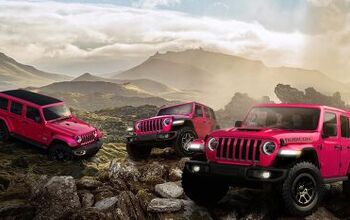2019 Hyundai Veloster Turbo Review - Hyundai Brings the Funk

2019 Hyundai Veloster Turbo Ultimate
Hyundai turned itself into a successful brand by building sensible, reliable cars and crossovers that match up nicely with the competition. Where rival carmakers have a product, Hyundai has a very similar alternative. Making a sale by imitating the class leaders is generally a winning strategy.
And then you have the 2019 Hyundai Veloster Turbo – a car that really has no similar rival. No other automaker offers an asymmetrical three-door, sloped-rear-light hatchback. No matter how functional it is or how well it drives, all conversations about the Veloster start with its funky layout.
Of course, what differentiates the Veloster from a more traditional hatchback are, for me, the big drawbacks. The asymmetrical door arrangement led to a pair of sisters climbing over one another to exit via the single rear door, and that sloping roof cuts down on rear headroom. Every time I drove over a speed bump, my five foot six eldest bashed her skull on the headliner.
Some of that headroom deficit may lie at the feet of the panoramic sunroof. The wide expanse of glass is nice, should one want a bit more airflow, but it cuts into the head space. Further, I was annoyed by a lack of body rigidity seemingly amplified by the gaping glass hole, as I noted a good number of squeaks, creaks, and rattles above my head, especially when driving spiritedly.
That’s a shame, because the 201 horsepower 1.6 liter turbocharged four practically begs you to go play. Power delivery is excellent, with minimal turbo lag – the full complement of 195 pound/feet of torque is available at 1,500 rpm. The seven-speed dual clutch transmission works well enough, though downshifts can be somewhat sluggish when trying to hustle on that deserted twisty road down by the river.
I beg you, however. If you do take the plunge on a Veloster of your own, make it a manual. While not Miata-perfect, the Hyundai six-speed manual pairs perfectly with this engine, making a very good car even more enjoyable.
Handling from the short-wheelbase Veloster is superb. While never quite straying into the oversteer category, the multi-link rear suspension (shared with the Elantra GT Sport I so adored last year) is happy to rotate when asked. My only note is an unusually strong self-centering action to the steering. It often feels as if the steering wheel is pulling you back to straight with more gusto than in most cars. My guess is the Veloster is designed to be aligned with more caster than the similar Elantra, to aid stability on interstate drives.
While my rear seat passengers complained about bopping their noggins, they were otherwise comfortable, and welcomed the convenient center-mounted cupholders. That plastic console does mean this is a car limited to four passengers, rather than five.
I love that Hyundai offers something more interesting than a typical black or charcoal interior – the off-white leather looks wonderful and brightens up the entire cabin. I’d be wary of how long it stays looking nice, of course. The asymmetry on the exterior continues inside, with differently colored sides of the dashboard and door panels. It’s one of those things that strikes you at first, but quickly fades into the background after a few days of living with the car.
Were I to sign a note on a Veloster Turbo – and not the Veloster N, which is an entirely different monster – I’d play right into my thrifty nature and specify the Turbo R-Spec. I’d lose the sunroof, heated seats, rain sensing wipers, leather, navigation, active cruise control, power lumbar support, and wireless cell charging, but I’d save nearly six thousand dollars. I’d miss the active cruise and wireless charger, but I’d have a car that fits me so much better. And it’s only available with the six-speed manual.
Make mine Sunset Orange.
Really, though, the Veloster Turbo is not the right fit for my family or my lifestyle. I need a bit more headroom and cargo space – I’m hauling kids everywhere all the time, it seems. But if you can live with the baked-in quirks – really, if you love those quirks simply because they are the essence of Veloster – than this funky warm hatch is a great choice.
[Images: © 2019 Chris Tonn/TTAC, screenshot via http://hyundaiusa.com]

Some enthusiasts say they were born with gasoline in their veins. Chris Tonn, on the other hand, had rust flakes in his eyes nearly since birth. Living in salty Ohio and being hopelessly addicted to vintage British and Japanese steel will do that to you. His work has appeared in eBay Motors, Hagerty, The Truth About Cars, Reader's Digest, AutoGuide, Family Handyman, and Jalopnik. He is a member of the Midwest Automotive Media Association, and he's currently looking for the safety glasses he just set down somewhere.
More by Chris Tonn
Latest Car Reviews
Read moreLatest Product Reviews
Read moreRecent Comments
- Bouzouki Cadillac (aka GM!!) made so many mistakes over the past 40 years, right up to today, one could make a MBA course of it. Others have alluded to them, there is not enough room for me to recite them in a flowing, cohesive manner.Cadillac today is literally a tarted-up Chevrolet. They are nice cars, and the "aura" of the Cadillac name still works on several (mostly female) consumers who are not car enthusiasts.The CT4 and CT5 offer superlative ride and handling, and even performance--but, it is wrapped in sheet metal that (at least I think) looks awful, with (still) sub-par interiors. They are niche cars. They are the last gasp of the Alpha platform--which I have been told by people close to it, was meant to be a Pontiac "BMW 3-series". The bankruptcy killed Pontiac, but the Alpha had been mostly engineered, so it was "Cadillac-ized" with the new "edgy" CTS styling.Most Cadillacs sold are crossovers. The most profitable "Cadillac" is the Escalade (note that GM never jack up the name on THAT!).The question posed here is rather irrelevant. NO ONE has "a blank check", because GM (any company or corporation) does not have bottomless resources.Better styling, and superlative "performance" (by that, I mean being among the best in noise, harshness, handling, performance, reliablity, quality) would cost a lot of money.Post-bankruptcy GM actually tried. No one here mentioned GM's effort to do just that: the "Omega" platform, aka CT6.The (horribly misnamed) CT6 was actually a credible Mercedes/Lexus competitor. I'm sure it cost GM a fortune to develop (the platform was unique, not shared with any other car. The top-of-the-line ORIGINAL Blackwing V8 was also unique, expensive, and ultimately...very few were sold. All of this is a LOT of money).I used to know the sales numbers, and my sense was the CT6 sold about HALF the units GM projected. More importantly, it sold about half to two thirds the volume of the S-Class (which cost a lot more in 201x)Many of your fixed cost are predicated on volume. One way to improve your business case (if the right people want to get the Green Light) is to inflate your projected volumes. This lowers the unit cost for seats, mufflers, control arms, etc, and makes the vehicle more profitable--on paper.Suppliers tool up to make the number of parts the carmaker projects. However, if the volume is less than expected, the automaker has to make up the difference.So, unfortunately, not only was the CT6 an expensive car to build, but Cadillac's weak "brand equity" limited how much GM could charge (and these were still pricey cars in 2016-18, a "base" car was ).Other than the name, the "Omega" could have marked the starting point for Cadillac to once again be the standard of the world. Other than the awful name (Fleetwood, Elegante, Paramount, even ParAMOUR would be better), and offering the basest car with a FOUR cylinder turbo on the base car (incredibly moronic!), it was very good car and a CREDIBLE Mercedes S-Class/Lexus LS400 alternative. While I cannot know if the novel aluminum body was worth the cost (very expensive and complex to build), the bragging rights were legit--a LARGE car that was lighter, but had good body rigidity. No surprise, the interior was not the best, but the gap with the big boys was as close as GM has done in the luxury sphere.Mary Barra decided that profits today and tomorrow were more important than gambling on profits in 2025 and later. Having sunk a TON of money, and even done a mid-cycle enhancement, complete with the new Blackwing engine (which copied BMW with the twin turbos nestled in the "V"!), in fall 2018 GM announced it was discontinuing the car, and closing the assembly plant it was built in. (And so you know, building different platforms on the same line is very challenging and considerably less efficient in terms of capital and labor costs than the same platform, or better yet, the same model).So now, GM is anticipating that, as the car market "goes electric" (if you can call it that--more like the Federal Government and EU and even China PUSHING electric cars), they can make electric Cadillacs that are "prestige". The Cadillac Celestique is the opening salvo--$340,000. We will see how it works out.
- Lynn Joiner Lynn JoinerJust put 2,000 miles on a Chevy Malibu rental from Budget, touring around AZ, UT, CO for a month. Ran fine, no problems at all, little 1.7L 4-cylinder just sipped fuel, and the trunk held our large suitcases easily. Yeah, I hated looking up at all the huge FWD trucks blowing by, but the Malibu easily kept up on the 80 mph Interstate in Utah. I expect a new one would be about a third the cost of the big guys. It won't tow your horse trailer, but it'll get you to the store. Why kill it?
- Lynn Joiner Just put 2,000 miles on a Chevy Malibu rental from Budget, touring around AZ, UT, CO for a month. Ran fine, no problems at all, little 1.7L 4-cylinder just sipped fuel, and the trunk held our large suitcases easily. Yeah, I hated looking up at all the huge FWD trucks blowing by, but the Malibu easily kept up on the 80 mph Interstate in Utah. I expect a new one would be about a third the cost of the big guys. It won't tow your horse trailer, but it'll get you to the store. Why kill it?
- Ollicat I am only speaking from my own perspective so no need to bash me if you disagree. I already know half or more of you will disagree with me. But I think the traditional upscale Cadillac buyer has traditionally been more conservative in their political position. My suggestion is to make Cadillac separate from GM and make them into a COMPANY, not just cars. And made the company different from all other car companies by promoting conservative causes and messaging. They need to build up a whole aura about the company and appeal to a large group of people that are really kind of sick of the left and sending their money that direction. But yes, I also agree about many of your suggestions above about the cars too. No EVs. But at this point, what has Cadillac got to lose by separating from GM completely and appealing to people with money who want to show everyone that they aren't buying the leftist Kook-Aid.
- Jkross22 Cadillac's brand is damaged for the mass market. Why would someone pay top dollar for what they know is a tarted up Chevy? That's how non-car people see this.










































Comments
Join the conversation
I would not eat Kimchee if it were given to me, Same with gook cars
I own a 2018 Elantra GT Sport, fully loaded, and I just traded my 2017 Elantra Value Edition sedan for a 2019 Elantra GT N-Line, also loaded. In addition, I test drove the Veloster Turbo Ultimate. All of these vehicles, with the DCT. I had my heart set on an Elantra Sport sedan, but because of "reasons" I got the Value Edition. Then the Elantra GT Sport came out, and I changed my mind. Then I drove the Veloster Turbo when IT came out, and changed my mind yet again. Though for a short time, before going back and forth between the Elantra Sport and the GT Sport/N-Line The Veloster is a hoot. It's fun, it's funky, and I love it. Even though it's just me and my partner, with no kids, it still ended up missing the mark and didn't end up being the "right" car for me. Here's why, and why I ultimately chose the GT N-Line over the Sport sedan (17-18, the 19 facelift is a huge miss): The Veloster's armrest is adequate for one person. Not two. And it doesn't slide forward. When he had a 16 Fiesta, we CONSTANTLY elbowed each other. The Elantra GT and sedan, have a wider one that slides forward. For reference, the Veloster Veloster and Elantra sedan, both have leather seats without a ventilation option. In Sunny California, and my sweaty butt and back, this was 90% a deal-breaker up front. Veloster has a weird and disparate options mix. Rain sensing wipers, when few Hyundai vehicles even offer that. Can I trade those for the vented seats? In essence, what I needed was the utility of a hatchback (nix sedan), and something more along the lines of a Touring car (GT) rather than a sport coupe (Veloster) It really is a car for just a single person or two for a trip, and that's it. Though the hatch opening is low, the seats DO fold down quite low and you can fit more in there than you think.